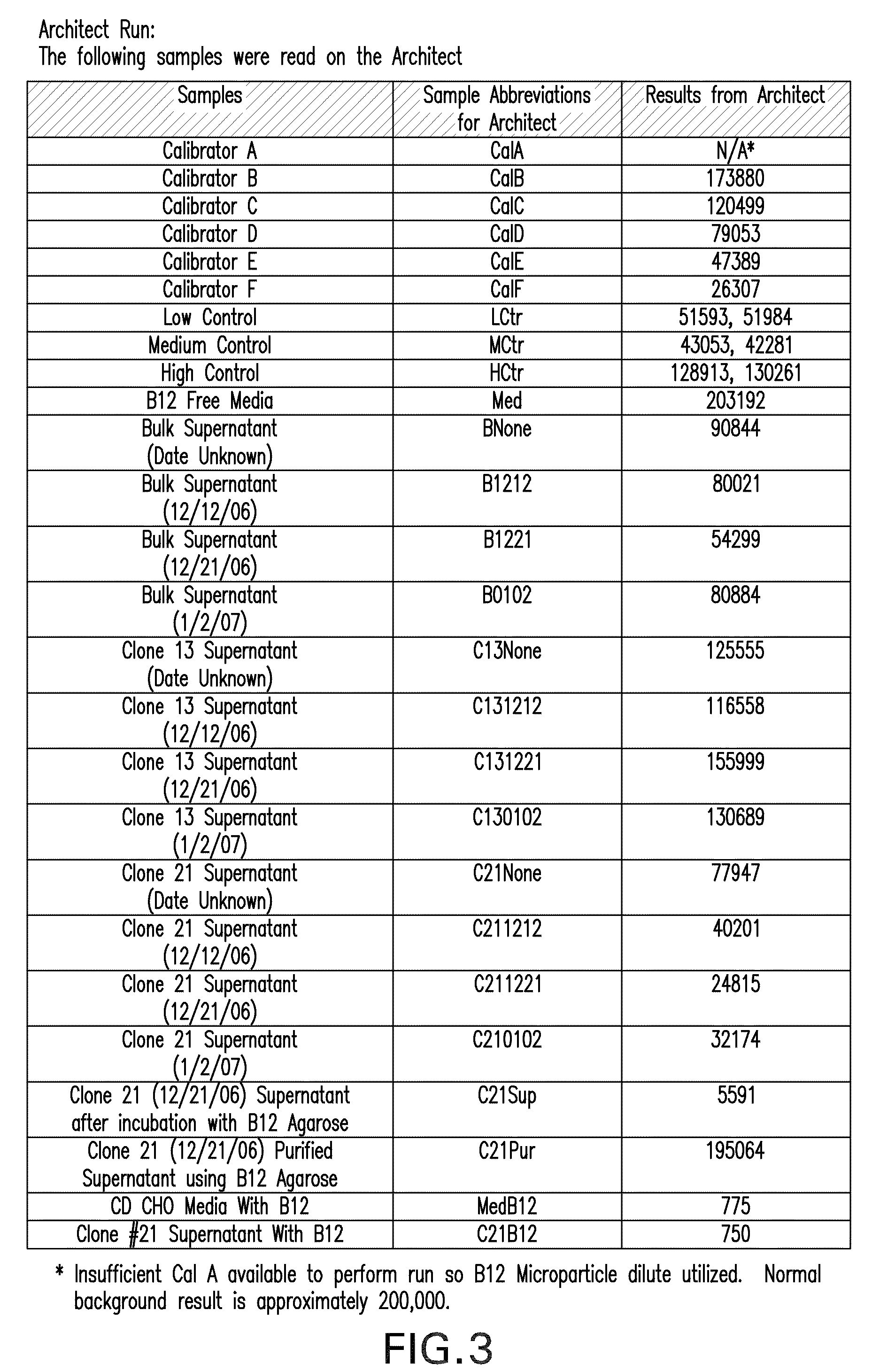Cloning, Expression And Purification Of Recombinant Porcine Intrinsic Factor For Use In Diagnostic Assay
a technology of intrinsic factor and purification method, which is applied in the field of cloning, expression and purification of recombinant porcine intrinsic factor for use in diagnostic assay, can solve the problems of low yield, laborious, time-consuming, and laborious isolation process of intrinsic factor protein, so as to reduce cost, simplify isolation, and improve consistency
- Summary
- Abstract
- Description
- Claims
- Application Information
AI Technical Summary
Benefits of technology
Problems solved by technology
Method used
Image
Examples
example i
Cloning of Porcine Intrinsic Factor into Eukaryotic Plasmid Vector
[0101]Intrinsic Factor (IF) is a glycoprotein 55-65 kDA in size that is produced by parietal cells in the stomach. Intrinsic Factor is necessary for the absorption of Vitamin B12 into the blood. Intrinsic Factor binds to free Vitamin B12 in the duodenum of the small intestine and transports Vitamin B12 to the ileum where it can be absorbed. The goal was to produce recombinant version of the porcine IF in an eukaryotic system using Chinese Hamster Ovary (CHO) cells.
[0102]Porcine Intrinsic Factor cDNA was produced using RT-PCR using total RNA extracted from porcine stomach tissues as the template and Forward primer hulF For 14 (SEQ ID No: 1) and reverse primer REV 1248 (SEQ ID No: 2). This resultant PCR product which is porcine Intrinsic Factor cDNA fragment, referred to herein as Porcine IF cDNA 14-1248, (1234 bp in length, denoted by SEQ ID 3, its reverse complement SEQ ID No. 4 and its amino acid sequence SEQ ID No. ...
example ii
Expression of Recombinant Porcine Intrinsic Factor in Chinese Hamster Ovary (CHO) Cells
[0104]A Chinese Hamster Ovary (CHO) cell line that is adapted for suspension growth (CHO-S cells, Gibco Cat. No. 11619-012) was used for the transfection of the rIF-pcDNA3.1 (+) plasmid and stable expression of the full-length porcine Intrinsic Factor. The CHO-S cells were grown at 35° C. in a humidified incubator supplied with 5% CO2. Cells were transfected with the rIF-pcDNA3.1(+) plasmid using the Invitrogen Lipofectamine 2000 Transfection Reagent Kit. Transfected cells were grown in a 6 well cell culture plate in CD CHO medium supplemented with 10 ml / L of HT Supplement, 8 mM L-Glutamine, 100 U penicillin, 100 ug streptomycin, and 2% FBS. Cells were then transferred into T75 cell culture flasks, and the FBS was removed from the medium for several passes.
[0105]The CHO-S cells transfected with the rIF-pcDNA3.1(+) plasmid were cloned by limiting dilution into CD CHO medium supplemented with 10 ml / ...
example iii
Demonstration of Binding of Recombinant Porcine Intrinsic Factor (rIF) Produced in CHO Cells to Anti-Intrinsic Factor Antibody using Western Blot Analysis
[0106]Supernatants from all 24 wells were tested for rIF production using Western blot analysis that resulted in the selection of six clones for further analysis. The six clones were scaled up into T75 flasks and carried for several more passages. The supernatants for the six clones (Clone #4, #8, #10, #13, #17, #21) were tested for rIF production using Western blot analysis (FIG. 1) that resulted in the selection of two clones (Clone #13 and Clone #21) for further analysis (FIG. 2).
[0107]In the Western Blot Analysis referred to as “Conjugate blots, protein from various cell lines were run on a SDS-PAGE and blotted to Nitrocellulose membrane. These blots were then probed with Vitamin B-12 conjugated to Alkaline phospatase. The substrate was added to develop the color reaction. The protein bands that bind Vitamin B12 light up in the...
PUM
| Property | Measurement | Unit |
|---|---|---|
| Fraction | aaaaa | aaaaa |
| Fraction | aaaaa | aaaaa |
| Fraction | aaaaa | aaaaa |
Abstract
Description
Claims
Application Information
 Login to View More
Login to View More - R&D
- Intellectual Property
- Life Sciences
- Materials
- Tech Scout
- Unparalleled Data Quality
- Higher Quality Content
- 60% Fewer Hallucinations
Browse by: Latest US Patents, China's latest patents, Technical Efficacy Thesaurus, Application Domain, Technology Topic, Popular Technical Reports.
© 2025 PatSnap. All rights reserved.Legal|Privacy policy|Modern Slavery Act Transparency Statement|Sitemap|About US| Contact US: help@patsnap.com



